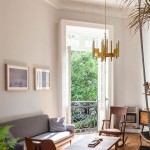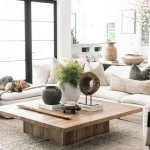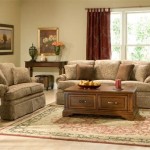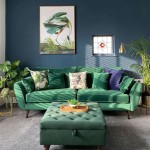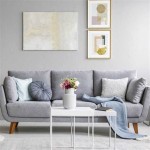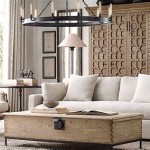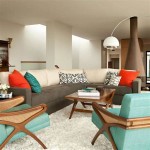Living Room Designs With Wallpaper: A Comprehensive Guide
Wallpaper, a time-honored design element, is experiencing a resurgence in popularity, offering a versatile and impactful method for transforming living room spaces. Far beyond the outdated perceptions of the past, modern wallpaper encompasses a vast array of textures, patterns, and materials, providing homeowners and designers with unprecedented creative freedom. This article explores the various ways wallpaper can be incorporated into living room designs, examining different styles, applications, and considerations for achieving optimal aesthetic results.
Understanding Wallpaper Types and Their Applications
The selection of the appropriate wallpaper type is paramount to the success of any living room design. Different materials offer varying levels of durability, washability, and ease of installation, impacting both the visual appeal and the longevity of the design. Some common wallpaper types include:
Vinyl Wallpaper: This is arguably the most popular type, known for its durability and ease of cleaning. Vinyl wallpapers are typically moisture-resistant, making them suitable for high-traffic areas and spaces prone to spills. They are available in a wide range of patterns and textures, and some variations are even scrubbable, providing added convenience.
Non-Woven Wallpaper: Composed of synthetic and natural fibers, non-woven wallpaper is breathable and dimensionally stable. This type is generally easier to install and remove than vinyl wallpaper, making it a favorable choice for DIY enthusiasts. It also tends to be more environmentally friendly.
Grasscloth Wallpaper: Made from natural fibers like jute, hemp, or seagrass, grasscloth wallpaper offers a unique textural element to living rooms. It provides a warm, organic feel and adds depth to the walls. However, grasscloth is more delicate than vinyl and requires careful handling. It is also less resistant to moisture and staining.
Fabric Wallpaper: This type of wallpaper features a fabric surface laminated to a paper or non-woven backing. Fabric wallpapers are luxurious and add a soft, elegant touch to living rooms. Silk, linen, and velvet are common fabric choices. However, fabric wallpapers are generally more expensive and require professional installation.
Peel and Stick Wallpaper: A relatively new addition to the market, peel and stick wallpaper offers a convenient, temporary solution for decorating living rooms. It is easy to apply and remove, making it ideal for renters or those who like to change their décor frequently. While peel and stick wallpaper has improved in quality, it may not be as durable as other types.
Exploring Design Styles and Wallpaper Patterns
The choice of wallpaper pattern and style significantly impacts the overall ambiance of the living room. The pattern should complement the existing furniture, color scheme, and architectural features of the space. Several popular design styles frequently incorporate wallpaper:
Traditional: Traditional living rooms often feature classic wallpaper patterns such as damask, floral prints, and toile. These patterns evoke a sense of elegance and formality. Rich colors like burgundy, gold, and navy are commonly used in traditional wallpaper designs.
Modern: Modern living rooms can benefit from geometric patterns, abstract designs, and bold colors. Minimalist patterns and textures, such as subtle stripes or textured plains, are also popular choices. Metallic accents, such as gold or silver, can add a touch of sophistication to modern wallpaper designs.
Bohemian: Bohemian living rooms often feature eclectic wallpaper patterns with vibrant colors and intricate details. Floral motifs, paisley prints, and global-inspired designs are commonly used. The key is to create a layered, textured look that reflects a relaxed and artistic sensibility.
Scandinavian: Scandinavian living rooms prioritize simplicity and functionality. Wallpaper designs in this style typically feature muted colors, such as gray, beige, and white. Geometric patterns and nature-inspired motifs are also common. The goal is to create a calm and inviting atmosphere.
Coastal: Coastal living rooms often incorporate wallpaper patterns that evoke the beach and ocean. Stripes, nautical motifs, and tropical prints are popular choices. Colors like blue, green, and white are commonly used to create a fresh and airy feel.
Considerations for Wallpaper Application and Room Size
The way wallpaper is applied in a living room can significantly impact its visual effect. Several factors should be considered when planning the wallpaper installation, including the size of the room, the placement of windows and doors, and the existing architectural features.
Accent Walls: Using wallpaper on a single accent wall is a popular and effective way to add visual interest to a living room without overwhelming the space. An accent wall can highlight a focal point, such as a fireplace or a piece of artwork. It can also be used to define a specific area within the room.
Full Room Coverage: While less common, wallpapering the entire living room can create a cohesive and immersive effect. This approach is particularly effective in smaller rooms, where the wallpaper can create a sense of intimacy and warmth. However, it is important to choose a pattern and color that are not too overwhelming, as this can make the room feel smaller.
Partial Coverage: Another option is to use wallpaper on a portion of the wall, such as above a wainscoting or below a chair rail. This approach allows for a blend of paint and wallpaper, creating a visually interesting and dynamic effect. It can also be used to add a touch of pattern to a room without committing to full wall coverage.
Room Size and Pattern Scale: The size of the room should influence the scale of the wallpaper pattern. In smaller rooms, smaller-scale patterns are generally more appropriate, as they will not overwhelm the space. Larger rooms can accommodate larger-scale patterns without feeling cramped. Vertical stripes can visually elongate a room, while horizontal stripes can make it appear wider.
Lighting Considerations: The lighting in the living room should also be considered when choosing wallpaper. Dark colors and patterns can absorb light, making the room feel smaller and darker. Lighter colors and patterns can reflect light, making the room feel brighter and more spacious. It is important to sample the wallpaper in the room and observe how it looks under different lighting conditions before making a final decision.
Preparing the Walls: Proper wall preparation is essential for a successful wallpaper installation. The walls should be clean, smooth, and free of any imperfections. Any holes or cracks should be filled and sanded before applying the wallpaper. Priming the walls with a wallpaper primer can also improve adhesion and prevent the wallpaper from peeling.
The impact of wallpaper extends beyond mere decoration. The texture and color of patterned wallpaper can affect how sound dissipates within a room. Certain textured wallpapers can absorb sound, improving the acoustics of a living space, which is particularly valuable in homes with hardwood floorings or minimal window treatments, which tend to increase echo. This acoustic benefit makes it a practical choice for those seeking to not only beautify but also improve the overall comfort of their living environment. Additionally, the strategic application of wallpaper can highlight architectural features. The appropriate selection of wallpaper can emphasize design details of a room. For example, a bold geometrical design on a single wall in a square room can visually extend the space, creating an illusion of depth and length. Wallpaper can also serve as a backdrop for a bookshelf which will make its contents stand out, and can be used to draw attention to a fireplace or other prominent area.
Furthermore, consider the environmental impact of wallpaper choices. Traditional wallpaper often contains volatile organic compounds (VOCs), which can release harmful chemicals into the air. Opting for eco-friendly alternatives, such as non-woven or natural fiber wallpapers with water-based inks, can significantly reduce the environmental footprint and contribute to a healthier living environment. These sustainable choices often provide the same aesthetic benefits without compromising indoor air quality. The application method also plays a role in sustainability. Using low-VOC or eco-friendly adhesives during installation minimizes chemical exposure and further supports environmentally conscious design practices. These factors combined can help create a beautiful, yet eco-friendly living room space.
Finally, consider the longevity of the wallpaper pattern in relation to personal style preferences. While some patterns may be trendy, selecting a design that aligns with a long-term aesthetic preference can minimize the need for frequent updates. Timeless patterns, such as subtle textures, geometric shapes, and sophisticated botanical designs, offer enduring appeal and can withstand changing trends. Incorporating elements of personal significance, whether through color choices or patterns that reflect personal interests, ensures that the wallpaper becomes an integral part of the living space, adding character and a sense of home. By carefully considering these factors, homeowners can create a space that not only reflects their individual taste but also remains stylish and relevant for years to come.

15 Best Elegant Living Room Wallpaper Ideas

Living Room Wallpaper Designs To Inspire You Designcafe

20 Inspiring Living Room Wallpaper Ideas Best Decorating

Living Room Wallpaper Designs To Inspire You Designcafe

Living Room Wall Decorating Ideas Wallpaper Design

Shop Living Room Wallpaper 3 Year Color Warranty

Top 100 Living Room Wallpaper Design Ideas 2024 Wall Painting Home Interior Decorating

Wallpaper Ideas For The Living Room 2024

Shop Living Room Drawing Hall Wallpapers Life N Colors

Modern Living Room Wallpaper For Wall Decoration 2024 Home Interior Painting Design Ideas

